Drilling is a very common operation performed during the fabrication of parts, assembly and installation. This section details the safe and effective use of drills and drill bits, including types of drills, terminology, drilling techniques and safety.
Care is necessary in the sharpening of a drill, the selection of suitable speed and feed, and the method of cooling the drill.
At the completion of this section you should be able to:
The twist drill is a rotary end-cutting tool with cutting lips and usually helical flutes. Straight-fluted drills are occasionally used.
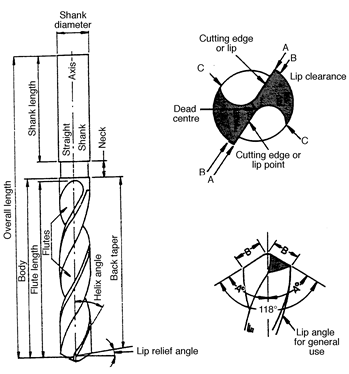
Figure 1: Straight shank twist drill
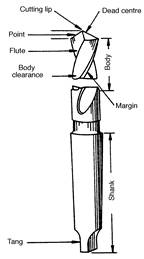
Figure 2: Tapered shank twist drill
Term |
Definition |
Axis |
The imaginary straight line which is the longitudinal centre line of the drill. |
Body |
The drill portion from the shank or neck to the outer corners of the cutting lips |
Body diameter clearance |
That portion of the land that has been cut away to prevent rubbing against the wall of the hole. |
Chisel edge |
The edge at the end of the web which connects the cutting lips. |
Chisel-edge angle |
The angle included between the chisel edge and the cutting lip, as viewed from the end of the drill |
Clearance diameter |
The diameter over the cut away portion of the drill lands. |
Drill diameter |
The diameter, measured at the point, between the two margins of the drill. |
Flutes |
Helical or straight grooves in the drill body to provide the cutting lips with paths for the chips to emerge, and to allow lubricant or coolant to flow to the cutting lips. |
Flute length |
The length of the flutes, measured along the axis. |
Helix angle |
The angle included by the leading edge of the land and the drill axis. |
Land |
The peripheral portion, of the drill body, between adjacent flutes. |
Land width |
The distance, measured at a right angle to the leading edge, between the leading edge and the land heel. |
Lips |
The cutting edges, of a two-flute drill, extending from the chisel edge to the periphery. |
Lip relief (clearance) angle: |
The axial relief at the outer corner of the lip, measured across the margin of the twist drill. |
Margin |
That portion of the land which is not cut away to provide clearance. |
Neck |
The reduced cross-sectional area between the body and shank of a drill. |
Overall length: |
It is the length from the extreme end of the shank to the outer corners of the cutting lips. |
Point: |
The drill cutting end comprising land ends, web and lips. |
Point angle: |
The angle included between the cutting lips. |
Shank: |
That part of the drill which is secured and driven. |
Tang |
The flattened end of a taper shank which is used for inserting into straight shank. |
Web |
The central portion of the body that separates the flutes. The extreme end of the web forms the chisel edge on a two-flute drill. |
Drilling is a continuous cutting operation that produces a circular hole in solid material. The cutting edges are in continuous contact with the work.
When drilling do not let long curls of steel develop as the drill cuts, and do not try to break them or brush them away with the hands. The curl may be broken by releasing the feed for a second. Another method is to take an open end spanner and run it down beside the drill and strike the curl — this will break it.
It is a mistake to use the same drill at the same speed for all materials. Different drills are designed to cut different materials. Always check the drill pack before use. You will avoid wasted time, wasted drills and possible accidents.
See the next page for a comprehensive guide on drill types for different materials. The angles are either increased or decreased depending upon the hardness or softness of the material to be drilled.
For drilling hard metals such as tool steel a point angle of about 136° can be used, and the lip clearance angle decreased to about 9°. For heat treated steel an point angle of 125° and lip clearance of 8° to 10° is recommended, and for soft grade cast iron an included angle of 90° and a lip clearance of 15° to 18° is recommended. For softer materials, the point angle may be further decreased.
In addition to the recommended drill points of Figure 3, the following notes will also be useful.
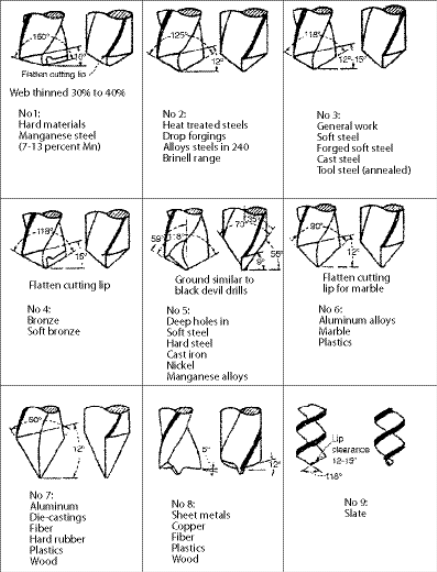
Figure 3: Recommended drilling angles for various materials.
Drills with cemented carbide cutting tips are used at very high speeds for drilling non-ferrous metals, but are not so practical for cast iron and steel because the carbide tips are not as well reinforced as are lathe, shaper, and other types of carbide-tipped tool bits.
Remember that cutting ability and hardness are different things. A high speed drill so hard that it cannot be filed may, by exercising great care, be made to drill extremely hard material, but such a drill will be so brittle as to be worthless if used for softer materials.
Table 1 is intended as a guide and in many cases it will be found that improved results will be obtained by increasing the speeds.
A good method of checking if the speeds and feeds are correct is to inspect the point after drilling a few components. If the outer corners of the cutting edges are showing signs of wear before the point, this is an indication of the speed being too high. If the point wears before the corners, this indicates the feed is too great.
Table 1: Drill speeds and lubricants
Material |
Peripheral |
Lubricants |
Aluminium |
10-15 |
kerosene |
Brass and Bronze |
7.5-12.5 |
dry |
Bronze (high tensile) |
3.5-5 |
dry or kerosene |
Cast Iron (soft) |
5-7.5 |
dry |
Cast Iron (hard) |
3.5-5 |
dry |
Cast Iron (chilled) |
1.5-2 |
dry |
Hard Plastics |
10-15 |
dry |
Malleable Iron |
4-4.5 |
soluble oil |
Nickel and Monel |
2-3 |
soluble oil |
Steel Machinery |
4-5 |
soluble oil |
Steel Annealed |
3-3.5 |
soluble oil |
Steel Tool (1.2C) |
2.5-3 |
soluble oil |
Steel Forged |
2.5-3 |
soluble oil |
Stainless Steel |
1.5-2 |
soluble oil |
Wood |
1.5-20 |
dry |
|
Student exercise 1 |
1 List and describe the main parts of a double-fluted twist drill and the functions of each.
2 What are the lip clearance angle and chisel angle for a correctly sharpened twist drill?
3 What is the purpose of flutes on a twist drill?
4 Name at least three types of shank design used on twist drills.
5 How are the sizes of drills up to 13 mm checked?
Check your answers with those given at the end of this section.
To maintain the speeds and feeds recommended without damage to the drill or the work, it is often necessary to use lubricant or cutting fluid.
The three functions of a cutting fluid are to:
Care must be taken that the cutting fluid reaches the cutting edge, otherwise its value is lost and the drill may be damaged by the generated heat drawing the temper of the drill.
Table 2: Recommended cutting fluids
Material being drilled |
Fluid |
Soft (mild) steel and wrought iron |
Lard oil; soluble oil; compound |
Hard and refractory steel |
Turpentine; kerosene; soluble oil |
Malleable iron |
Soluble oil |
Brass |
Dry; kerosene; compound |
Copper |
Lard oil; kerosene |
Aluminium and soft alloys |
Kerosene; soluble oil |
Cast iron |
Dry or with a jet of compressed air for a cooling medium |
Glass |
Turpentine; kerosene |
When drilling deep vertical holes, release the feed occasionally and withdraw the drill. Remove the chips from the bottom of the hole with an old round file that has been magnetised.
The drilling of marble and similar materials, especially when the drill is fed by hand, can be facilitated by grinding a narrow slot in the point of the drill (See Figure 17). This slot should be about 3 mm to 6 mm deep according to the size of drill, and at an angle of a little less than 90° with the cutting edges. If the slotting is carefully done the drill will give good results.
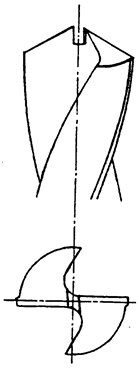
Figure 4: Drilling of marble
Slate, on account of its peculiarly stratified formation, may present some difficulty when drilling. It is necessary to have something under the slate slightly larger than the diameter of the drill, to support the pressure of the drill, otherwise the slate will fracture. Drill No. 9 of Figure 16 is suitable for this purpose, the flutes being wide and usually chromium plated.
The flat drill ground thin at the point is also suitable for drilling slate.
When drilling marble or slate, excess pressure may damage the back of the panel as the drill emerges.
When starting the drill on a curved surface, the latter should be cut away with a chisel to allow the drill to have a flat seat to commence cutting, otherwise the hole may be out of position and the drill may snap.
Drilling can be used to advantage in the making of slots, especially where hand processes with chisels and hack saws are to be later carried out.
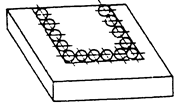
Figure 5: Setting out
A series of holes are drilled in the waste portion and along the desired contour of the slot. Position the holes with centre spacing 1 mm greater than the drill diameter, and with the edges 1 mm from the finished contour: this allowance provides for finishing the job. The marking off of the holes will be facilitated by the use of a centre punch.
The shearing punch or drift, (Figure 6), in small jobs may drive the web out in one piece, but in other cases the web may have to be sheared from both sides. Do not use an ordinary chisel as this has a wedging action - in some jobs a chisel will distort the work. Note the square shearing profile of a drift, as against the wedge shape of a chisel.
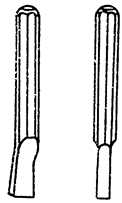
Figure 6: Drift for shearing thin web.
Figure 7 shows a five-hole slot with the web sheared between four of the holes. If the job is small it may be held in a vice with the jaws just below the line of the contour. Large pieces should be placed on a metal bench block or anvil having a recess to line up with the holes.
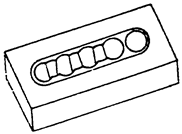
Figure 7: How to drill for a slot
Where the same drilling operation is to be repeated, it is advisable to adopt some system whereby the complete marking off of each piece can be avoided. The process adopted must permit reasonable speed according to the degree of accuracy and number of pieces required.
A marking template or template consists of a piece of material having the same shape as the finished article.
Templates are used where the parts have to be marked out, a record of sizes or the shape of layout of some part kept for future reference, or holes transferred from one part to another.
The template is usually laid over the surface and located on centre lines or by some other method, and if necessary clamped in position, after which the outline, etc., is marked on the surface with a scriber. Where required the various lines are pop marked.
Templates are made from different materials depending on the accuracy required and materials at hand, for example building paper, sheet zinc, mild steel plate.
Paper templates can be made by placing paper over the object and tapping lightly with a mallet round the piece thereby cutting the paper.
Usually, it is preferable to have only centre holes in the template rather than full sized holes. There is less likelihood of distorting the template, less time is required for marking off, and the template may be used for marking tapping size holes in one member and clearance holes in another. Dividers can be set to mark out clearance or tapping holes as desired.
Table 3 summarises common drilling problems.
Table 3: Drilling problems
Symptoms |
Probable Cause |
Remedy |
Hole too large |
Unequal angle or length of the cutting edges – or both; loose spindle |
Regrind properly, test spindle for rigidity |
Only one lip cutting |
Unequal length or angle of cutting lips or both |
Regrind drill properly |
Splitting up centre |
Too little lip clearance; too much feed |
Regrind with proper lip clearance; reduce feed |
Rough hole |
Dull or improperly ground drill; lack of lubricant or wrong lubricant; improper set-up; too much feed |
Regrind properly, lubricate or change lubricant; reduce feed |
Breaking of drill |
Spring or back lash in press work. Too little lip clearance. Too low speed in proportion to the feed. Dull drill |
Test press and work for rigidity and alignment; regrind properly; increase speed or decrease feed; sharpen drill. |
Breaking down of outer corners of cutting edges |
Material being drilled has hard spots, scale or sand inclusions. Too much speed. Improper cutting compound. No lubricant at point of drill |
Reduce speed; use proper cutting compound and correct application. |
Broken drill when drilling brass or wood |
Chips clog up flutes |
Increase speed; use drills designed for these materials. |
Broken tang |
Imperfect fit of taper shank in the socket—due to nicks, dirt, burrs or worn out socket |
Get a new socket or ream old one to prevent recurrence. |
Chipping of margin |
Oversize jig bushing |
Use proper size bushing |
Chipping of lip or cutting edges |
Too much feed; too much lip clearance |
Reduce feed; regrind properly |
Chipping or checking of a high speed drill |
Heated and cooled too quickly while grinding or while drilling; too much feed |
Warm slowly before using; do not throw cold water on hot drill while grinding or drilling; reduce feed. |
Change in character of chips while drilling |
Change in condition of the drill such as chipping of cutting edge, dulling, etc. |
Regrind drill properly |
The twist drill is a precision tool and must be ground accurately. Sharpening should be carried out in a special drill sharpening machine. Small, inexpensive drills are usually considered as disposable when blunted.
When it is necessary to sharpen by hand on an ordinary abrasive wheel, great care must be taken to ensure that the angles and lengths of cutting edges are equal.
The sharpening should be done on the peripheral face which should be running true. Hold the shank of the drill with the right hand, the left hand resting on the tool rest with fingers holding the body of the drill.
Stand with the axis of the drill at approximately 60° with the axis of the wheel spindle. Commence grinding with the drill practically horizontal and the cutting edge just touching the face of the wheel. Exert a light pressure on the cutting edge and pivot the drill by lowering the shank, thus grinding from the cutting edge to the heel, and increasing the pressure on approaching the heel, thus providing for lip clearance. Do not attempt to grind heavily, but instead repeat the above process a number of times, being careful to prevent overheating. After repeating the grinding process several times for one cutting edge, revolve the drill and repeat for the other cutting edge.
When grinding a drill, use a gauge to check the:
Care must be taken to avoid overheating. With carbon steel drills great care is necessary to avoid discolouring due to heat. The drill should be cooled off in water from time to time to avoid any possibility of overheating.
High speed steel drills should not be plunged into water when hot, as this may cause fracture.
 |
Student exercise 2 |
1 State the probable cause and remedy for:
(a) breaking of a drill
(b) a change in the colour, length and character of the waste curls (or chips).
2 Name three functions of a cutting fluid used in a drilling operation.
3 Name the recommended cutting fluids for the following:
(a) soft (mild) steel
(b) brass
(c) cast iron
Check your answers with those given at the end of this section.
|
Check your progress |
1 Name the types of shanks used with double-fluted twist drills.
2 List the conditions that determine whether a drill cuts true and to the correct size.
3 List the three most common spindles used to accommodate the tool holder of a bench drilling machine.
4 What safety precautions should be taken prior to using a bench drilling machine?
5 What is a suitable point angle for a twist drill if used to cut mild steel?
6 Across which parts of a twist drill is the true diameter of the drill measured?
7 When securing a tapered shank drill in a spindle socket, what important factor must be observed, if the drill is to receive its full driving torque?
Answers to Check your progress are at the end of the section.
1 The main parts and functions are:
2 Lip clearance angle and chisel angle are:
3 The purpose of the flutes is to:
4 Types of shank design are:
5 Drill plate gauges are used.
1 (a) Broken drill - Probable Causes: Spring or back lash in press or work; too little lip clearance; too low speed in proportion to the feed; dull drill. Remedies: Test press and work for rigidity and alignment; regrind properly. Increase speed or decrease feed. Sharpen drill
(b) Overheating - Probable Causes: Change in condition of the drill such as chipping of cutting edge, dulling, etc. Remedy: Regrind drill
2 (a) Lubricate the tool
(b) Cool the tool and the work
(c) Assist in the removal of chips
3 (a) Soluble oil
(b) Nil (dry) or kerosene
(c) Nil (dry) or compressed air jet for cooling only
1 The types are taper, straight, parallel, round without flat, round with flat.
2 The conditions are: the two cutting lips must be of equal length; the two cutting lips must be at equal angles to the axis of the drill; both lips must be free of cracks and chips; the chisel angle must be central to the drill diameter; the drill must be straight.
3 The spindles are:
4 The operator must wear eye protection, be suitably dressed (including cap if needed) and be sure the chuck key is removed and that all guards are in place.
5 118 degrees
6 across the lands
7 Locate the tang of the drill in the matching slot in the spindle, or sleeve.
Source: http://lrr.cli.det.nsw.edu.au/LRRDownloads/5109/1/5109_1.doc
Web site to visit: http://lrr.cli.det.nsw.edu.au/
Author of the text: indicated on the source document of the above text
If you are the author of the text above and you not agree to share your knowledge for teaching, research, scholarship (for fair use as indicated in the United States copyrigh low) please send us an e-mail and we will remove your text quickly. Fair use is a limitation and exception to the exclusive right granted by copyright law to the author of a creative work. In United States copyright law, fair use is a doctrine that permits limited use of copyrighted material without acquiring permission from the rights holders. Examples of fair use include commentary, search engines, criticism, news reporting, research, teaching, library archiving and scholarship. It provides for the legal, unlicensed citation or incorporation of copyrighted material in another author's work under a four-factor balancing test. (source: http://en.wikipedia.org/wiki/Fair_use)
The information of medicine and health contained in the site are of a general nature and purpose which is purely informative and for this reason may not replace in any case, the council of a doctor or a qualified entity legally to the profession.
The texts are the property of their respective authors and we thank them for giving us the opportunity to share for free to students, teachers and users of the Web their texts will used only for illustrative educational and scientific purposes only.
All the information in our site are given for nonprofit educational purposes